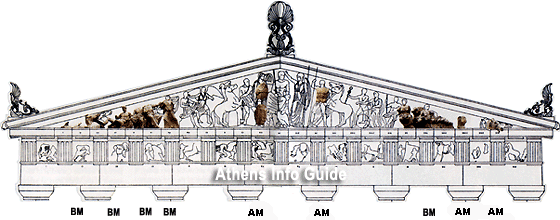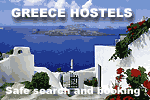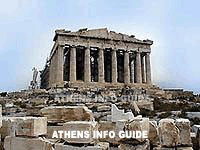 The
Parthenon
The
Parthenon
Glory
of the Acropolis
O gentleness! O beauty so simple and real! Goddess, for whom
the cult means reason and wisdom, for whom the shrine is an
eternal study in conscience and sincerity, belated I arrive
at the threshold of your mysteries. There is no salvation for
the world, unless it returns to you. - Ernest Renan.
Before
480 BC
and at the same place the Parthenon is at now, one had started
building a temple, the Proparthenon. It was the first big
marble temple in Athens, equal in size to the present Parthenon.
This temple was destroyed when the Persians took possession
of the Acropolis in 480 BC. Later, parts of this temple
were used in the wall of Kimon.
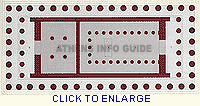 Under
Pericles and on top of the fundaments of the previous temple,
the Tempe of Athena Parthenos was erected and finished between
447 and 432 BC. The architects of this temple, a masterpiece
in Greek building art, were Iktinos en Kallikatres. Pheidias,
a friend of Pericles, had the overall supervision of the construction
works on the Acropolis.
Under
Pericles and on top of the fundaments of the previous temple,
the Tempe of Athena Parthenos was erected and finished between
447 and 432 BC. The architects of this temple, a masterpiece
in Greek building art, were Iktinos en Kallikatres. Pheidias,
a friend of Pericles, had the overall supervision of the construction
works on the Acropolis.
In
the 6th century AD. the Parthenon became a Christian church,
with the addition of an apse at the east end. It next served
as a mosque and a minaret was added to it. In 1687, in the Venetian
attack on Athens, it was used as a powder warehouse by the Turks
and the entire center portion was destroyed by an explosion.
The
Parthenon is built with Pentelic marble. It is a Doric temple
with Ionic elements. At the east and west facades there are
two Doric galleries with six columns. The building is surrounded
by a Doric gallery with 8 columns at the short and 17 at the
long side. 
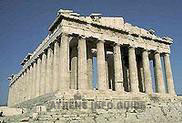 Tricks
Tricks
Except for the fact that the Doric and the Ionic style were
used next to each other, there are other elements that make
the Parthenon the unique creation it is. In order to get a more
satisfying ecstatic effect, the building masters used a few
architectonic tricks:
This
way the deviation the human eye creates was corrected.
The
outside Doric frieze had 92 metopes with figures in relief.
On the east side the Gigantomachia or battle with the giants
was depicted and on the west side the Amazonomachia or battle
with the Amazons. The south side had the Kentauromachia (battle
with the centaurs) and the north side showed the capture of
Troje. The metopes that survived time are kept in the British
Museum, the Louvre, the Acropolis Museum and on the temple itself.
The
east pediment showed the birth of Athena from the head of her
father Zeus and on the west pediment the battle between Poseidon
and Athena was illustrated. The roof of the temple had akrotiria
(kind of roof statues) in the form of twined plants.
The
frieze of the Parthenon has 360 human figures in total as well
as a big number of animals. All move towards the east where
the handing over of the peplos takes place in the presence of
the Gods and the most important people of the town. In this
great composition all acquisitions of the Athenian democracy
are melted together. 
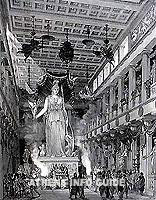 Giant Athena
Giant Athena
The cella of the Parthenon is 30 meters long (98,4ft) and is
exceptionally wide. Usually the inner room was not big as there
were no religious services held. They were held on altars in
the open air. The Parthenon was the first exception even though
services outside were also continued.
There
was another reason for the inner room to be this large.
The giant 12 meters (39,4ft) tall statue of Athena Parthenos,
made of ivory and gold, had to be put in the cella. Pheidias,
the artist, had made the statue of the goddess bearing full
armor holding a small Nike in one of her hands. The pedestal
showed the mythological scene of the birth of Pandora. In
front of the statue there was a basin with water. It was
there to humidify the ivory and keep it in good shape. The
reflection in the water also gave the statue dignity.
The
statue of Athena Parthenos was surrounded with a two-story
column gallery in the form of a Greek character  . The west
part of the Parthenon, closed off by a slant wall, was used
as treasure room for sacred objects. The inner room had
four Ionic columns in two rows.
. The west
part of the Parthenon, closed off by a slant wall, was used
as treasure room for sacred objects. The inner room had
four Ionic columns in two rows.
The
Ionic frieze that circled the temple on the inside, was right
under the ceiling. This 160 meters (525ft) masterwork of Pheidias
showed the most important manifestation of the worship of the
goddess Athena, the Panathenaic procession. The big Panathenaic
games were held every four years in the honor of Athena Polias.
During this festival that went on for a week, musical and athletic
competitions took place. The highlight of the festival was the
Panathenaic procession which ended in the symbolic offer of
a new peplos to the wooden statue of Athena Polias in the Erechtheion.
The
peplos would show embroided scenes of the battle of the
giants and it was transported on a wagon in the form of
a ship on wheels. The procession started from the Pompeion
in Kerameikos, crossed through the Agora, followed the Panathenaic
road to end at the holy rock. The offering of the peplos
would be followed by an offer of about hundred animals and
a meal for all the citizens .
Where is what?

 The
Parthenon
The
Parthenon
 Tricks
Tricks Giant Athena
Giant Athena